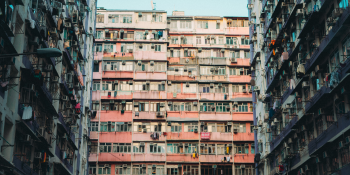Bridging the property insurance gap: Insights from the ILO-TCIS-Britam Project
For many low-income families and small businesses in Kenya, a single disaster—such as a fire or flood—can mean financial ruin. Shockingly, 35% of Kenyans have lost homes, businesses, or property due to fire, floods, theft, or eviction in the last two years, yet few have access to property insurance to protect their assets.
Across Africa, only 4.5% of people with microinsurance have property coverage, compared to 52% for life insurance and 22% for health insurance. This disparity leaves millions exposed to financial shocks, highlighting the often overlooked faced by low-income families and small businesses.
Without adequate insurance, rebuilding after disasters is a slow and uncertain process, keeping families and businesses in a cycle of economic vulnerability.
Recognizing this gap, Habitat for Humanity’s Terwilliger Center for Innovation in Shelter (TCIS) partnered with the International Labour Organization’s (ILO) Impact Insurance Facility and Britam Insurance to develop affordable and accessible property microinsurance solutions. Through this initiative, more than 109,800 new policyholders—including MSMEs, women, and rural residents—gained access to affordable insurance for their homes and businesses, offering them a critical financial safety net.
Barriers to property insurance adoption
Phase 1 of the project identified key barriers to property insurance adoption:
- Lack of awareness – Many potential customers are unaware of property insurance and its benefits.
- Complex policies – Technical jargon and lengthy contracts discouraged sign-ups.
- Affordability concerns – Rigid payment structures made it difficult for low-income families to access coverage.
To overcome these challenges, the project focused on simplifying insurance policies, raising awareness, and introducing flexible payment models that made insurance more accessible to underserved communities.
Challenges and lessons learned
While Phase 1 made significant strides in bridging the insurance gap, challenges remain:
- Market hesitancy – Some insurers are cautious about developing new inclusive products.
- Low demand perception – Even among aggregators, there was limited interest in property insurance beyond mortgage providers.
- Need for better distribution – Finding the right channels to reach low-income consumers is critical for long-term success.
Looking ahead: What to expect in phase 2
Building on the successes and lessons from Phase 1, Phase 2 will focus on:
- Scaling flood insurance – Expanding coverage to better protect climate-vulnerable communities.
- Integrating early warning systems – Helping households and businesses prepare for and mitigate risks.
- Expanding access: Aiming to reach over 300,000 policyholders by the end of 2025 and 500,000 by the end of 2026.
Inclusive property insurance is a powerful tool for resilience, ensuring that when disaster strikes, families and businesses can rebuild faster and more effectively.
Read the full report here:
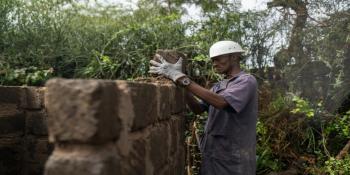
Bridging the property insurance gap: Insights from the ILO-TCIS-Britam Project
Unlocking Lithuania’s Renewable Energy Potential
Lithuania has made significant strides toward achieving a climate-neutral economy by 2050, with renewable energy (RE) at the heart of this transition. However, while the country continues to expand its RE capacity, some key challenges remain—especially for homeowners in multi-family buildings. A recent study highlights how legal, financial, and informational barriers are slowing the adoption of small-scale renewable energy solutions, despite a growing interest in energy efficiency upgrades. The research is part of the SUNRISE project.
Lithuania has made significant strides toward achieving a climate-neutral economy by 2050, with renewable energy (RE) at the heart of this transition. However, while the country continues to expand its RE capacity, some key challenges remain—especially for homeowners in multi-family buildings. A recent study highlights how legal, financial, and informational barriers are slowing the adoption of small-scale renewable energy solutions, despite a growing interest in energy efficiency upgrades.
The research is part of the SUNRISE project.
Funded by the European Climate Initiative (EUKI), the project is focused on supporting the deployment of solar power installations in multi-family buildings across North Macedonia, Bulgaria, and Lithuania. Running from 01.11.2022 to 30.04.2025, the project is led by Initiative for Housing in Eastern Europe (IWO) in partnership with Habitat Bulgaria, Lithuanian Consumers Alliance (LCA), Habitat for Humanity International (HFHI), German Solar Energy Company (DGS), and Habitat Macedonia.
Challenges for Multi-Family Buildings
Multi-family buildings make up nearly 50% of Lithuania’s housing stock, presenting a major opportunity for implementing smaller RE solutions like solar water heaters, heat pumps, and rooftop PV systems.
However, several factors complicate the process:
- Complex decision-making – Unlike single-family homes, these buildings require approval from multiple owners, making it difficult to reach consensus on energy renovations.
- Regulatory hurdles – Permitting processes can be lengthy and complicated, discouraging homeowners from pursuing RE investments.
- Financial constraints – While homeowners recognize the long-term benefits of RE, many struggle with the high upfront costs and lack awareness of available subsidies or low-interest loans.
- Limited knowledge – Even as general awareness of RE grows, many homeowners lack technical knowledge about system performance, costs, and maintenance.
What Motivates Homeowners to Invest in Renewable Energy?
Despite these challenges, the research shows that financial benefits are the strongest motivator for RE adoption. Homeowners are primarily interested in lowering their energy bills, reducing environmental impact, and increasing property value. However, the relatively low cost of electricity for shared building needs means that without state support, many remain hesitant to invest.
Another key finding is the critical role of homeowner association (HOA) leaders in driving change. Targeted training programs can equip HOA chairs with accurate, practical information on financing options, administrative procedures, and technology benefits, enabling them to guide their communities toward informed decisions.
Accelerating Renewable Energy Adoption in Lithuania
To unlock the full potential of RE in Lithuania’s multi-family buildings, a multi-faceted approach is needed:
- Simplifying administrative procedures – Reducing bureaucratic barriers and streamlining permitting processes to make RE adoption more accessible.
- Expanding financial support – Increasing grants, subsidies, and low-interest loans to help cover installation costs.
- Enhancing information accessibility – Developing targeted awareness campaigns and training HOA leaders to share RE knowledge effectively.
- Strengthening grid infrastructure – Addressing technical limitations that prevent easy integration of RE solutions into existing energy networks.
Building a Sustainable Future
Lithuania’s renewable energy adoption depends on proactive policy changes, financial accessibility, and community engagement.
By removing barriers and providing the right support, the SUNRISE project is building a cleaner, more energy-efficient future.
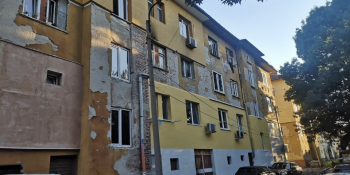
Unlocking Lithuania’s Renewable Energy Potential
Overcoming Regulatory Barriers and Empowering Multi-Family Buildings
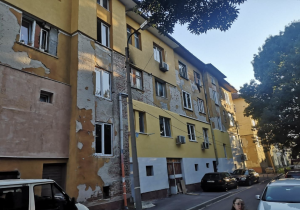
Bridging the Energy Gap
As Bulgaria continues to embrace renewable energy (RE) solutions, the differences in financial readiness, awareness, and willingness to invest between neighborhoods highlight the need for tailored approaches to energy transition. A recent assessment of two multifamily residential buildings—one in Zaharna Fabrika and another in Knyazhevo—provides valuable insights into the factors influencing RE adoption and the steps needed to bridge existing gaps. The research is part of the SUNRISE project.
As Bulgaria continues to embrace renewable energy (RE) solutions, the differences in financial readiness, awareness, and willingness to invest between neighborhoods highlight the need for tailored approaches to energy transition. A recent assessment of two multifamily residential buildings—one in Zaharna Fabrika and another in Knyazhevo—provides valuable insights into the factors influencing RE adoption and the steps needed to bridge existing gaps.
The research is part of the SUNRISE project.
Funded by the European Climate Initiative (EUKI), the project is focused on supporting the deployment of solar power installations in multi-family buildings across North Macedonia, Bulgaria, and Lithuania. Running from 01.11.2022 to 30.04.2025, the project is led by Initiative for Housing in Eastern Europe (IWO) in partnership with Habitat Bulgaria, Lithuanian Consumers Alliance (LCA), Habitat for Humanity International (HFHI), German Solar Energy Company (DGS), and Habitat Macedonia.
By overcoming key barriers, SUNRISE is making it easier for communities to embrace cleaner, more sustainable energy solutions.
Understanding the Two Neighborhoods
The study compares two contrasting communities in Bulgaria: Zaharna Fabrika, a lower-income neighborhood with limited completed energy efficiency renovations, and Knyazhevo, a higher-income area with greater investment potential but lingering skepticism toward RE solutions. While both neighborhoods show an interest in RE, their financial and informational barriers require distinct solutions.
Key Challenges Identified
The research identifies key challenges for the adoption of renewable energy (RE) in two neighborhoods: Zaharna Fabrika and Knyazhevo. These challenges include gaps in awareness and information about available financing programs, with Zaharna Fabrika residents particularly uninformed.
While most households are willing to invest in RE, Knyazhevo residents have a higher investment capacity, while Zaharna Fabrika households need substantial external financial support. Trust issues, complex administrative processes, and skepticism about the benefits of RE also hinder adoption. Additionally, many residents are unaware of the financial benefits of contributing surplus energy to the grid.
Strategies to Accelerate RE Adoption
To accelerate RE adoption, the research recommends several strategies.
These include targeted awareness campaigns tailored to each neighborhood’s needs, enhanced financial support mechanisms such as grants and preferential loans, and facilitating collective financing through homeowners’ associations (HOAs).
Simplifying administrative procedures and reducing bureaucratic barriers would also help, along with educating households about energy sales and storage solutions to encourage the efficient use of surplus energy.
These efforts aim to make RE adoption more accessible and practical for residents, fostering greater participation in sustainable energy solutions.
Moving Forward
The findings from Zaharna Fabrika and Knyazhevo reinforce the importance of targeted, community-specific approaches to RE adoption. Financial incentives, regulatory reforms, and structured information campaigns will play a crucial role in overcoming existing barriers.
By implementing these strategies, Bulgaria can accelerate its transition to a more sustainable energy future, ensuring equitable access to renewable solutions for all households.

Bridging the Energy Gap
Overcoming Financial and Informational Barriers to Renewable Energy Adoption in Bulgarian Multifamily Buildings
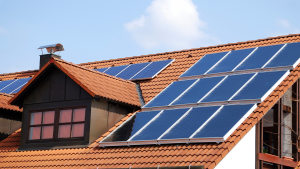
Powering Homes with Solar Energy
As climate change continues to impact our planet, transitioning to renewable energy sources like solar power (PV) has never been more urgent. Not only do these sources help reduce greenhouse gas emissions, but they also enhance energy independence. This is where the SUNRISE project comes in.
As climate change continues to impact our planet, transitioning to renewable energy sources like solar power (PV) has never been more urgent. Not only do these sources help reduce greenhouse gas emissions, but they also enhance energy independence.
This is where the SUNRISE project comes in.
Funded by the European Climate Initiative (EUKI), the project is focused on supporting the deployment of solar power installations in multi-family buildings across North Macedonia, Bulgaria, and Lithuania. Running from 01.11.2022 to 30.04.2025, the project is led by Initiative for Housing in Eastern Europe (IWO) in partnership with Habitat Bulgaria, Lithuanian Consumers Alliance (LCA), Habitat for Humanity International (HFHI), German Solar Energy Company (DGS), and Habitat Macedonia.
By overcoming key barriers, SUNRISE is making it easier for communities to embrace cleaner, more sustainable energy solutions.
Why Solar Energy?
Switching to solar power isn’t just good for the environment—it can also help families save money on energy bills and become more energy independent. However, despite its benefits, many people face significant challenges when trying to install solar panels in their apartment buildings. These include:
- High upfront costs
- Complicated legal and bureaucratic processes
- Lack of clear information and support
- Concerns about maintenance and long-term reliability
The SUNRISE project aims to break down these barriers by promoting plug-in photovoltaic (PV) systems, which are easy to install and require minimal effort from homeowners. It also advocates for net metering, allowing households to sell excess electricity back to the grid—helping them save even more.
What Have We Learned from the research in North Macedonia
To understand how to best support homeowners, a team of researchers conducted surveys, interviews, and focus groups with residents and homeowner associations in Skopje and Bitola. The findings were both encouraging and eye-opening:
- People Want Solar Energy – 75% of those surveyed said they were aware of solar power, and 72% would invest in it if financial barriers were reduced.
- Money Is a Major Concern – 68% cited high upfront costs as the biggest challenge, and only 21% felt financially secure enough to make the investment without outside help.
- The Legal Process Is Complicated – 64% of people in apartment buildings said getting approval from all residents was difficult, slowing down the transition to renewable energy.
- Better Information Is Needed – Over half (55%) of participants were unaware of existing financial aid options, like subsidies and low-interest loans.
- Maintenance Worries People – 51% of respondents were hesitant to invest because they were unsure about long-term maintenance and repair costs.
The Path Forward
To make solar energy more accessible, the SUNRISE project recommends:
- Increasing financial support – Expanding subsidies and creating low-interest loans to help with the initial cost.
- Simplifying legal procedures – Making it easier for residents in apartment buildings to install solar systems without excessive paperwork.
- Boosting public awareness – Running information campaigns so people understand how solar energy works and where to get financial support.
- Ensuring long-term maintenance – Setting up reliable services for installation, repairs, and upkeep.
With the right support, North Macedonia can start helping families reduce energy costs, protect the environment, and achieve greater energy independence.
The SUNRISE project is working on cleaner, greener future.
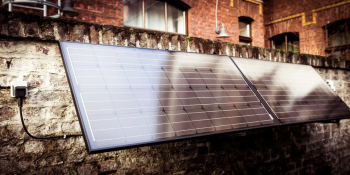
Powering Homes with Solar Energy
How the SUNRISE Project is Making Renewable Energy More Accessible in North Macedonia
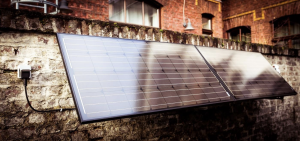
Addressing Energy Poverty and Housing Shortages in Europe
Europe is facing a dual crisis—an escalating housing shortage and a pressing need to reduce carbon emissions. With over 900,000 people homeless each night and 30 million vacant homes across Europe, the paradox is striking: while many struggle without adequate shelter, millions of properties remain unused. At the same time, residential buildings account for 36% of CO₂ emissions and 40% of energy consumption in the EU.
Europe is facing a dual crisis—an escalating housing shortage and a pressing need to reduce carbon emissions. With over 900,000 people homeless each night and 30 million vacant homes across Europe, the paradox is striking: while many struggle without adequate shelter, millions of properties remain unused. At the same time, residential buildings account for 36% of CO₂ emissions and 40% of energy consumption in the EU.
Zuzana Matloňová, representing Habitat for Humanity International for Europe and the Middle East, recently addressed these urgent challenges at two key events: the Right to Energy Forum and Reclaiming Vacant Spaces to Create Housing Solutions. These gatherings brought together experts dedicated to reshaping Europe’s housing landscape. These events showcased real solutions—solutions that Habitat for Humanity is already driving forward.
A Path Out of Energy Poverty through Targeted Renovations
At the Right to Energy Forum, organised by Right to Energy Coalition, Zuzana took part in a panel discussion alongside representatives from Justice Ensemble, Housing Europe, and Ecodes, moderated by Lea Segura from Friends of the Earth. Her focus was on How smart, community-driven renovations can lift people out of energy poverty in Central and Eastern Europe (CEE).
“One of the greatest ironies is that, unlike in Western Europe where renting is more common, most people in CEE own their apartments. However, rather than providing financial security, these homes are often a burden due to high energy costs. Poor insulation, outdated heating systems, and inefficient household appliances leave many families choosing between heating and essentials like food,” she highlights.
Habitat for Humanity’s EU funded ComAct and ComActivate projects, tackle this crisis with a three-pillar approach:
1) Technical Solutions – Conducting energy audits and planning cost-effective building upgrades.
2) Financial Support – Identifying the best financial models, from government subsidies to commercial mortgages.
3) Community Engagement – Encouraging homeowners to work together for large-scale, collective renovations.
Zuzana also drew connections between these projects and another Habitat initiative: Empty Spaces to Homes supported by Laudes Foundation, which focuses on transforming vacant buildings into affordable housing. Both projects share the goal of maximizing energy efficiency while respecting planetary boundaries.
A New Approach to Affordable Housing
The second event, Reclaiming Vacant Spaces to Create Housing Solutions, hosted by FEANTSA, explored innovative ways to repurpose empty spaces into homes. Habitat for Humanity presented a bold vision to bridge the gap between overcrowded living conditions and the millions of vacant properties left unutilized.
During the roundtable discussion, Habitat-promoted Social Rental Agency model emerged as a promising solution. Successfully implemented in Poland in 2021 by Habitat for Humanity, this initiative allows private homeowners to lease properties to social rental agencies, which refurbish them and rent them out at below-market rates to vulnerable groups. This model proved critical during the Ukraine crisis, providing immediate housing for displaced families.
Taking it a step further, Habitat’s Empty Spaces to Homes project presents a holistic strategy for transforming vacant spaces. It incorporates:
- Social Impact – Creating stable, affordable housing for those in need.
- Financial Viability – Leveraging government incentives and sustainable financial models.
- Environmental Responsibility – Demonstrating how repurposing existing buildings can cut CO₂ emissions by up to 85% compared to new construction.
Given that the construction sector accounts for 35% of Europe’s total greenhouse gas emissions, Empty Spaces to Homes is also developing carbon footprint assessment methodologies to align with EU sustainability targets.
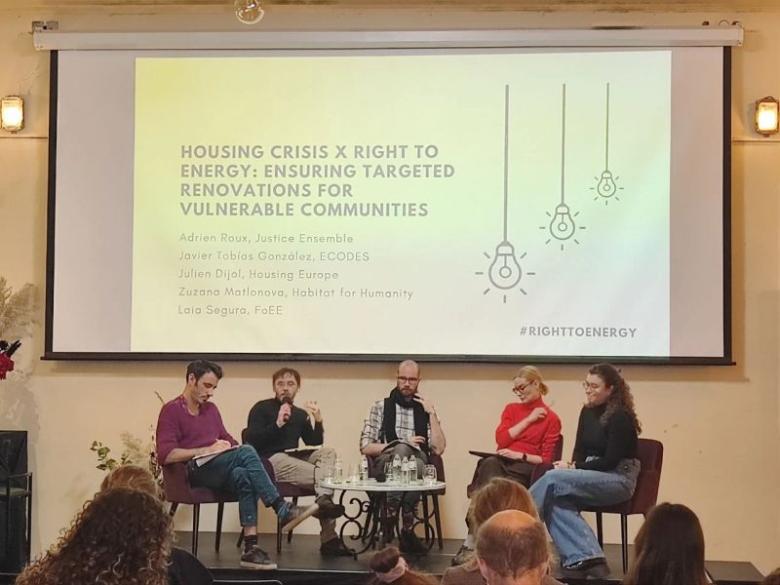
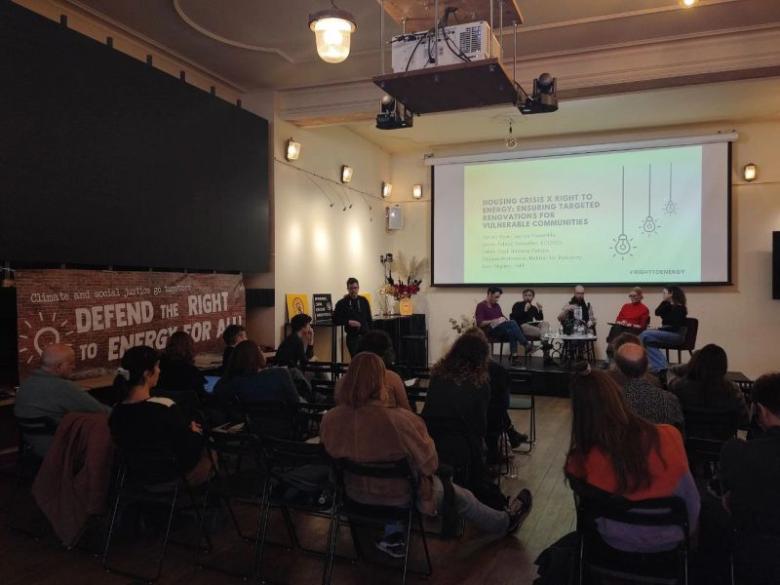
The Key to Systemic Change is by the Advocacy
While these projects offer practical, scalable solutions, Zuzana emphasized that real change requires more than just technical and financial interventions. Advocacy and public awareness are crucial. As she put it, “We can do many fantastic things in-house, but if we don’t tell the world about it, it is as if it doesn’t exist.”
Every person can play a role in this movement—whether by supporting policy changes, spreading awareness, or engaging in local initiatives. The fight against energy poverty and housing shortages is about transforming systems to create sustainable, long-term solutions.
Scaling Solutions for a Global Impact
With pilot projects already underway, Zuzana and her team at Habitat for Humanity aim to expand these initiatives across Europe and beyond. By blending research, financing, environmental sustainability, and community action, ComActivate and Empty Spaces to Homes are leading the way toward a future where housing is easily accessible as well as energy-efficient and sustainable.
Europe’s housing and energy crisis is complex, but solutions exist. With coordinated action, innovative models, and a commitment to advocacy, we can turn vacant spaces into homes, lower energy costs, and build a future where no one has to choose between warmth and food.
